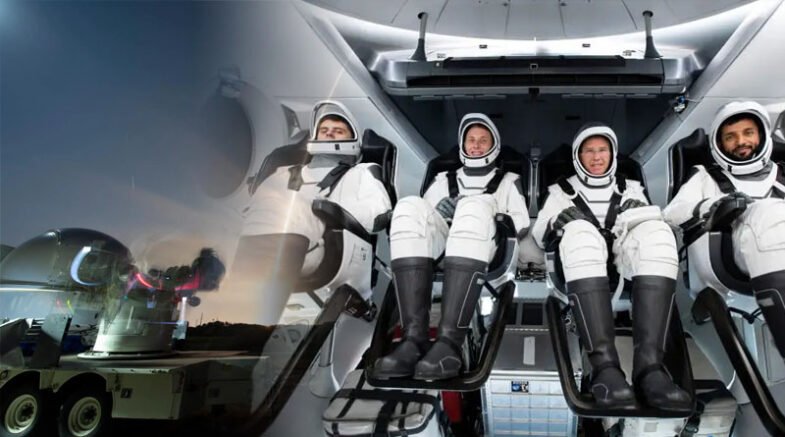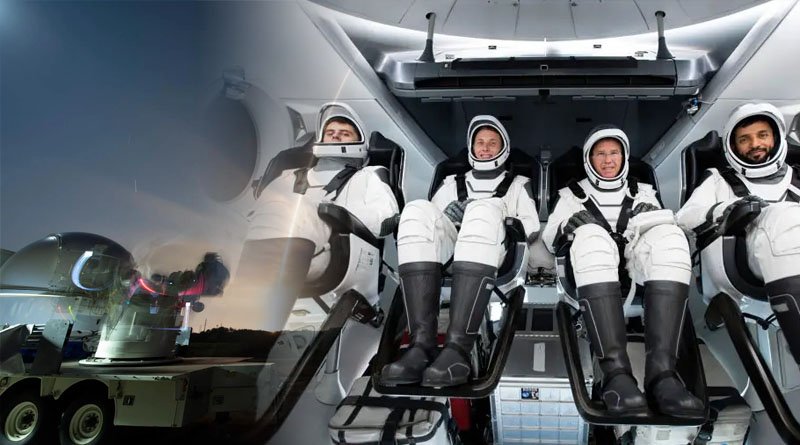SpaceX Crew-6 will advance human exploration beyond low-Earth orbit and improve life on Earth by conducting fresh scientific research.

NASA’s SpaceX Crew-6 crew members successfully launched to the International Space Station at 12:34 a.m. EST on Thursday from Launch Complex 39A at NASA’s Kennedy Space Center in Florida. As of now, they are in orbit. The six-commercial crew rotation mission for the agency with SpaceX aboard the orbital laboratory features the international crew.
NASA astronauts Warren Hoburg and Stephen Bowen, along with cosmonauts Andrey Fedyaev of Roscosmos and Sultan Alneyadi of the United Arab Emirates, were aboard the Dragon spacecraft Endeavour when it was launched into orbit by a SpaceX Falcon 9 rocket. They were travelling to the International Space Station for a science mission.
NASA and SpaceX teams have successfully completed a history-making mission to the International Space Station, with Crew-6 conducting over 200 experiments to prepare for missions to the Moon, Mars, and beyond and improve life on Earth.
SpaceX will monitor the flight from its mission control center in Hawthorne, California, and NASA teams will monitor space station operations from the Mission Control Center at the agency’s Johnson Space Center in Houston.
The Commercial Crew Program is proof American ingenuity and leadership in space benefits all of humanity through groundbreaking science, innovative technology, and newfound partnership.
Dragon will dock autonomously to the space-facing port of the station’s Harmony module at 1:17 a.m. on Friday, March 3. NASA Television, the NASA app, and the agency’s website will provide live coverage of the docking and hatch opening.
Crew-6 will join Expedition 68, consisting of NASA astronauts Frank Rubio, Nicole Mann, and Josh Cassada, as well as JAXA (Japan Aerospace Exploration Agency) astronaut Koichi Wakata, and Roscosmos cosmonauts Sergey Prokopyev, Dmitri Petelin, and Anna Kikina.
For a short time, the 11 crew members will live and work in space together until Crew-5 members Mann, Cassada, and Wakata return to Earth a few days later.
SpaceX Crew-6 will advance human exploration beyond low-Earth orbit and improve life on Earth by conducting fresh scientific research.
Studies of how certain materials burn in microgravity, research on the functions of the heart, brain, and cartilage using tissue chips, and an investigation to gather microbial samples from the outside of the space station are just a few of the experiments planned.
These are merely a few of the many hundreds of scientific investigations and technological displays that will take place throughout their mission.
Humans have been living and working on the International Space Station for more than 20 years, according to Kathryn Lueders, associate administrator for NASA’s Space Operations Mission Directorate in Washington.
“Crew-6 and other Commercial Crew Program missions are crucial for maximising the critical research that is only possible in the special microgravity environment of the space station. Congratulations to the SpaceX and NASA teams on a job well done! I can’t wait to see the crew on the station in safety.”
The Crew-6 mission will help NASA make the most of the space station, where astronauts have continuously lived and worked for more than 22 years, testing technologies, conducting science, and honing the skills necessary to run upcoming commercial space stations in low-Earth orbit and explore farther from Earth.
Through NASA’s Artemis missions, research on the space station benefits people on Earth and paves the way for upcoming lengthy trips to the Moon and beyond.
Roscosmos cosmonaut Andrey Fedyaev, NASA astronaut Warren “Woody” Hoburg, NASA astronaut Stephen Bowen, and UAE (United Arab Emirates) astronaut Sultan Alneyadi are seen as they prepare to depart the Neil A. Armstrong Operations and Checkout Building for Launch Complex 39A to board the SpaceX Dragon spacecraft for the Crew-6 mission launch.
This will be Bowen’s fourth trip into space as a veteran of three space shuttle missions. He will be responsible for all phases of flight, from launch to re-entry, and will serve as an Expedition 68-69 flight engineer aboard the station.
Bowen was born in Cohasset, Massachusetts and holds a bachelor’s degree in electrical engineering from the United States Naval Academy in Annapolis, Maryland, and a master’s degree in ocean engineering from the Joint Program in Applied Ocean Science and Engineering offered by Massachusetts Institute of Technology (MIT) in Cambridge, Massachusetts, and Woods Hole Oceanographic Institution in Falmouth, Massachusetts.
In July 2000, Bowen became the first submarine officer selected as an astronaut by NASA. Hoburg’s first flight since his selection as an astronaut in 2017 will be his first flight as a pilot, and he will serve as a flight engineer.
Hoburg is a Pittsburgh native. He graduated from MIT with a bachelor’s in aeronautics and astronautics and from the University of California, Berkeley, with a doctorate in electrical engineering and computer science.
Hoburg was an assistant professor of aeronautics and astronautics at MIT at the time of his selection as an astronaut. Hoburg’s research focused on effective techniques for engineering system design. He holds commercial pilot certifications in single-engine, multi-engine, and instrument flying.
Alneyadi will be travelling to space for the first time on behalf of the UAE’s Mohammed bin Rashid Space Center. Alneyadi is the first astronaut from the UAE to travel in a private spacecraft. He will join Expeditions 68 and 69 as a flight engineer once on board the station.
Fedyaev will be travelling to space for the first time and working as a mission specialist to monitor the spacecraft during its challenging launch and re-entry phases. He will be Expedition 68–69’s flight engineer.
